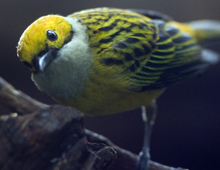
Despite their name, the several species of fruitcrows are not related to crows at all, though they do eat many kinds of fruit, which they gather both while in flight and perching in trees. Like many other members of the cotinga family, the males have a distinctive display, courting the all black females by flaring out their brilliant throat feathers (which can appear bright red), shaking their tails back and forth and making piercing calls. A relative of the Cock-of-the-rock, this species has only rarely been kept in captivity, despite being found over a vast area of South America, as well as Costa Rica and Panama. It was not bred in a zoo until 2006, when the Wuppertal Zoo in Germany was successful.











